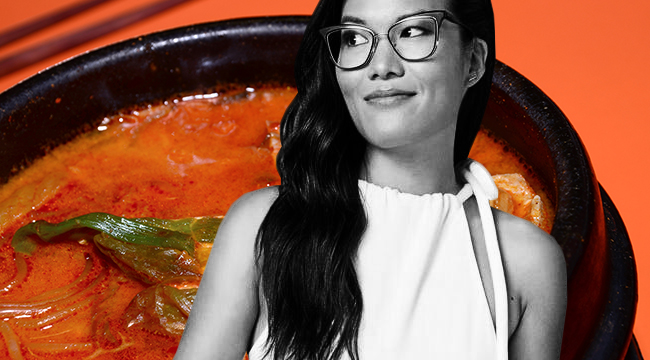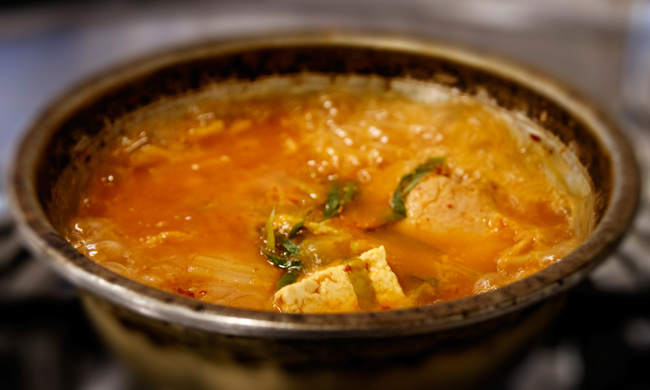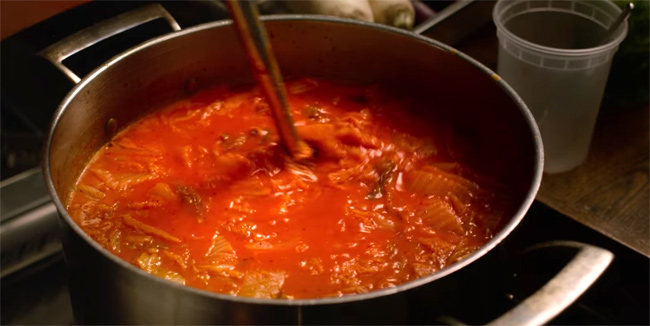
If you watched Always Be My Maybe on Netflix this past week, you were treated to a healthy dose of food porn. Like Crazy Rich Asians and The Trip movies before it, Always Be My Maybe is a comedy in name, but cooking is its secret weapon. In fact, food is so important in Always Be My Maybe that they even had a food consultant: Niki Nakayama, chef-owner of n/naka in Los Angeles.
In the film, Ali Wong’s character — a Vietnamese-American who learns to cook with her Korean neighbors — goes off to become a celebrity chef-restaurateur. But there’s one dish in particular that basically forms the emotional center of the film, the one that Wong’s character learns from Randall Park’s character’s mother at the beginning, and then cooks later in the film when she’s getting back to her roots, so to speak. Kimchi jjigae.
The kimchi jjigae in Always Be My Maybe is not quite as front and center as the timpano in Big Night (I actually had to rewind it the first time to catch the name), but it’s definitely something you watch and immediately want to eat. Disappointed that I knew nothing about this apparently classic Korean comfort food, I brought in a Korean food ringer, Irene Yoo, to ask if I could pick her brain about the dish. Irene runs Yooeating, a Korean-American comfort food pop-up that highlights Korean home-cooking, street food, and drinking culture. She was born in Detroit to Korean-immigrant parents, and, she says, “raised on home-cooked Korean meals in California and street vendors in Seoul.” She currently lives in Brooklyn.

Okay, so what is the dish and how is it made?
The dish is called kimchi jjigae (김치찌개), or kimchi stew. It’s a spicy stew made by boiling well-fermented kimchi with tofu, pork, and onion/green onion, usually in an anchovy stock or meat stock.
What’s the history/cultural significance of it?
I would say kimchi jjigae isn’t the timpano of Korean food – it’s not this super impressive meal that takes hours and would seriously wow a crowd. It’s more like your classic red sauce spaghetti if I’m continuing in the Big Night theme (God I love that movie). It’s probably the most classic Korean stew, and almost any Korean mom will make it on any given weeknight.
At its core, it’s a good way to use up a lot of kimchi, especially if it’s gone a bit too fermented/sour, as well as any other odds and ends you might have in the fridge.

Any other thoughts on the movie, food-wise? Anything you think they nailed or whiffed?
I think the thing that hit home most for me was that first scene where Ali Wong’s child character comes home from school and makes herself a bowl of rice with furikake and fries up some slices of Spam, which was my favorite afternoon snack as a kid. It was a great indicator of how much love my mom was putting out that day: bare minimum if she would slap some rice and furikake in a bowl with soy sauce and sesame oil and have me mix it myself, and full throttle if she would cut up spam, batter them in a flour-egg wash and fry ’em up. That scene made me feel SEEN.
Also, I don’t want to hate on the kimchi jjigae as the emotional delivery point of the movie, but the jjigae they show in the movie looks like it’s just a pot of soupy boiled kimchi, without any of the other accouterments that would be served in it, and also looked SUPER spicy. Though I’m sure there’s a family out there where this looks legit to them, without the scene having named it as kimchi jjigae I would have had no idea that’s what it was supposed to be.
The lead into the first kimchi jjigae scene has the kids talking about bringing (I assume the kimchi jjigae?) thermos soup to school. My mom would have never sent me a thermos of it to school, cuz that shit is stinky. In fact, my mom would make me give her a three days heads up if I was ever bringing a friend over so she would make sure to not cook any kimchi jjigae during that time.
And YES Koreans use scissors for frigging everything, it is probably used just as much as actual knives are. Great for cutting meat, scallions, noodles, etc.

Vince Mancini is on Twitter. You can access his archive of reviews here.






